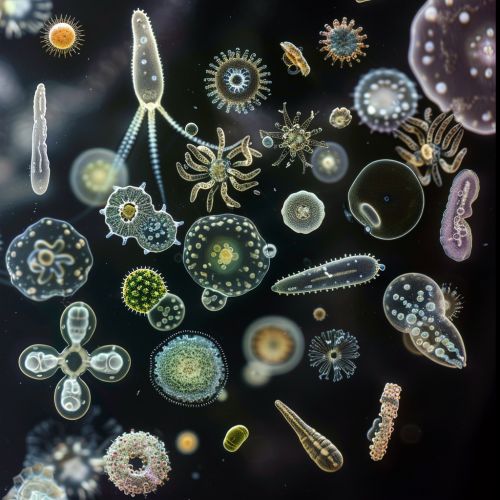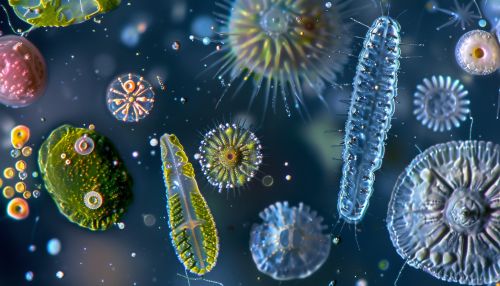Protozoa
Introduction
Protozoa are a diverse group of unicellular eukaryotic organisms, many of which are motile. Originally, protozoa had been defined as unicellular organisms with animal-like behaviors, such as motility and predation. The group was regarded as the zoological counterpart to the "protophyta", which were considered to be plant-like, as they are capable of photosynthesis.


Characteristics
Protozoa are notable for their ability to move independently, a characteristic found in the majority of species. They usually have a diameter of 10–52 micrometers, but can grow up to 1 mm, and are thus widely visible under a microscope. Protozoa are ubiquitous and are found in almost every possible habitat. The fossil record in the form of shells in sedimentary rocks shows that protozoa were present in the Pre-Cambrian era.
Protozoa are primarily free-living organisms, but some are parasitic. They are common in aquatic environments, both freshwater and marine. Some protozoa are also found in soil, mosses, and lichens, and in environments such as waste treatment plants.
Classification
Protozoa have traditionally been divided on the basis of locomotion. Although this is no longer the case, these groups are still often treated as a valid taxon for convenience. There are four general classifications of protozoa: Amoeboids, Flagellates, Ciliates, and Sporozoans.
Amoeboids
Amoeboids are protozoa that move by means of pseudopods, which are bulges of cytoplasm formed by the coordinated action of actin microfilaments pushing out the plasma membrane that surrounds the cell. The appearance and internal structure of pseudopods are used to distinguish groups of amoeboids from one another.
Flagellates
The flagellates are defined by their means of locomotion, a whip-like appendage called a flagellum. Some flagellates can be parasites, while others can be predators.
Ciliates
The ciliates are a group of protozoa characterized by the presence of hair-like organelles called cilia. Cilia are identical in structure to eukaryotic flagella, but are in general shorter and present in much larger numbers, with a different undulating pattern than flagella.
Sporozoans
Sporozoans are a group of parasitic protozoa, and include the causative agents of malaria and toxoplasmosis. They are characterized by their spore-forming abilities.
Reproduction
Protozoa typically reproduce asexually by binary fission but they also have a variety of sexual reproduction modes. They can exchange genetic material through the process of conjugation, which is not a form of reproduction, but a type of genetic exchange.
Role in Ecosystem
Protozoa play a role in the nitrogen cycle as decomposers breaking down organic materials to produce detritus and nutrient cycling. They also function as a food source for other organisms. Protozoa also have a role in controlling bacteria populations and biomass.
Pathogenic Protozoa
Some protozoa are parasitic and can cause diseases in their hosts. These include diseases such as malaria, caused by the protozoan parasite Plasmodium, and amoebic dysentery, caused by Entamoeba histolytica.
